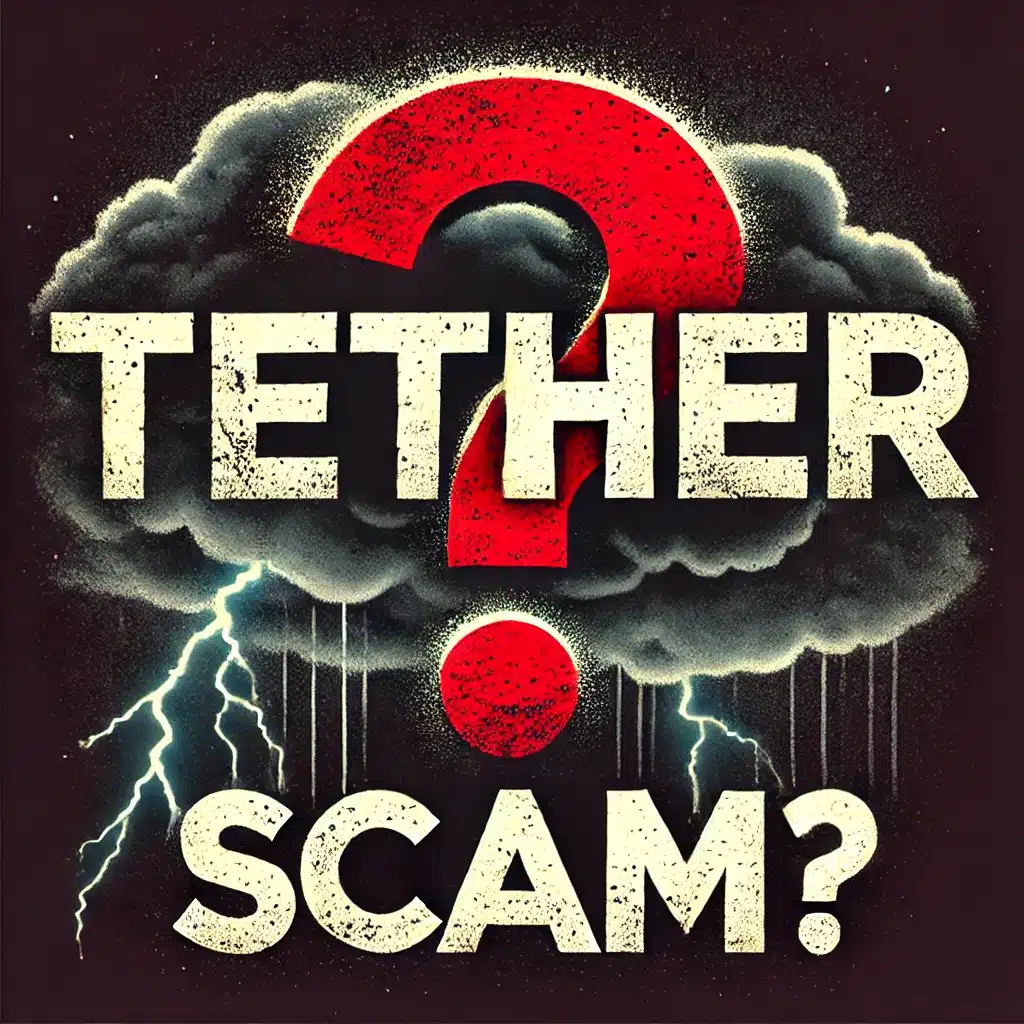What If Tether Were Just A Big Scam?

What if Tether were Just a Big Scam?
Tether (USDT) plays a crucial role in the cryptocurrency ecosystem, providing liquidity and acting as a stable value refuge amidst the volatility of other digital assets. However, the question remains whether Tether is fully backed by actual reserves or not.
The detailed breakdown from Tether’s Q1 2024 attestation shows that their claimed reserves total approximately $110.3 billion, while their liabilities, mainly consisting of the digital tokens issued, are around $104 billion. This would indicate that Tether maintains a surplus, with assets exceeding liabilities by over $6 billion.
However… not all is as clear as they make it look.
Tether (USDT) Printed Out of Thin Air?
There are accusation that Tether (USDT) is printed out of thin air and that Tether issues more USDT tokens than it has actual dollar reserves to back them up. In the below video you can learn more about the Tether anomalies.
Keep in mind that when new USDT is issued, Tether Ltd. receives fiat currency deposits from customers and issues an equivalent amount of USDT tokens on various blockchains. This issuance increases the total supply of USDT. When customers redeem USDT for fiat currency, Tether Ltd. should send the fiat currency back to the customer and the corresponding amount of USDT tokens should be destroyed or “burned.” But what if that doesn’t happen all the time?
One of the most significant criticisms of Tether is the lack of comprehensive, independent audits. While Tether provides attestations from firms like BDO, these are not the same as full audits. An attestation confirms that the data presented by Tether matches what was observed at a specific time, but it does not involve a thorough examination of Tether’s financial health and practices over a longer period.
And although Tether has pledged to increase transparency by publishing real-time reserve data, past behavior has raised doubts about its commitment. Historical transparency issues, such as inconsistent reporting and delays in providing financial details, have undermined confidence in Tether’s disclosures.
Tether’s reserve composition has evolved, and it claims that 90% of its reserves are in cash and cash equivalents. But critics argue that not all assets classified as cash equivalents are equally liquid or safe.
When you expose the #Tether scam at a bitcoin conference 😂🤣😅$USDT https://t.co/EgPl5YGMuA
— Crypto Informer (@cryptoinformer0) October 16, 2023
Tether has faced legal challenges, including a case with the New York Attorney General, which resulted in a settlement and a fine of $18.5 million. The investigation revealed that Tether had misrepresented the extent to which its tokens were backed by fiat currency. This legal history casts serious doubt on Tether’s claims and reliability.
If Tether were revealed to be a scam, the repercussions would be far-reaching and severe.
Tether’s ongoing minor depeg shows its Achilles heel – the inability to redeem for fiat in size.
— Novacula Occami (@OccamiCrypto) July 2, 2024
Tether announced 1Q24 profits of $4.5bn, $11.4bn of group equity and $6.3bn of USDT excess reserves
Yet USDT is incapable of holding to its $1 peg (its trading 15bps below par as… pic.twitter.com/mwOFBN9sLE
And X is full of not so positive tweets regarding Tether.
The Tether conspiracy theories weren't conspiracy theories after all? Because it sure sounds like Tether's spokesperson just admitted to them.
— John Paul Koning (@jp_koning) September 22, 2023
via @matt_levinehttps://t.co/tUfxTG0LiJ pic.twitter.com/RyXBJuQ33U
Immediate Market Impact
The potential systemic risk posed by Tether to the broader cryptocurrency market cannot be ignored. Tether’s widespread use for trading and liquidity means that any significant issue with its reserves or backing could trigger a market-wide crisis. Given that Tether’s market cap exceeds $100 billion, a loss of confidence could lead to severe liquidity problems and price crashes across multiple cryptocurrencies.
There’s lots of clear scams running in crypto, the biggest one of course is tether which is a proven fraud that underpins the whole market. Pretty much everyone is fooled by the most obvious fraud of all. pic.twitter.com/3WdSMrFUpL
— Bitfinex'ed 🔥🐧 Κασσάνδρα 🏺 (@Bitfinexed) November 4, 2023
If Tether is exposed as unbacked or significantly under-backed, the immediate effect would be a catastrophic loss of value for USDT. Traders and investors would rush to sell off their holdings, causing a rapid depreciation. This could trigger a broader market panic. Bitcoin and other cryptocurrencies would experience extreme volatility as traders attempt to liquidate their holdings or convert to other stable assets. Given Tether’s integration into many trading pairs, liquidity would dry up, exacerbating the price drops.
Exchanges that heavily rely on USDT for liquidity would face immediate challenges. As USDT holders rush to sell or withdraw their assets, the liquidity on these exchanges could dry up quickly, causing trading halts and withdrawal suspensions. Many trading pairs on exchanges are denominated in USDT, and the collapse of its value would lead to unpredictable swings in cryptocurrency prices, potentially causing panic selling and market instability.
And it doesn’t stop there for the exchanges. Regulators would likely increase scrutiny on exchanges that offered Tether, investigating their role in promoting or facilitating trading with an unbacked stablecoin. This could lead to legal actions, fines, and stricter regulatory requirements for these exchanges. Add to this that exchanges could face lawsuits from users as well who suffered losses due to the collapse of Tether.
Broader Economic and Regulatory Repercussions
Such a revelation would prompt regulators to scrutinize the entire stablecoin market more rigorously. Governments and financial authorities might impose stricter regulations and oversight, not just on Tether but on all stablecoins and cryptocurrency exchanges. This increased regulatory burden could stifle innovation and reduce the overall attractiveness of the crypto market.
Investors who suffer losses would likely pursue legal action against Tether and its affiliated entities. This could lead to prolonged and complex legal battles, with large financial and operational repercussions for the involved parties.
Long-term Market Effects
The collapse of Tether would undermine confidence in other stablecoins, regardless of their actual backing and transparency. This trust deficit could lead to a significant reduction in the usage of stablecoins, pushing investors towards more transparent and regulated alternatives or back to traditional fiat currencies.
Many DeFi platforms rely heavily on stablecoins for various functions, including lending, borrowing, and liquidity provision. Tether’s collapse would disrupt these platforms, causing a cascade of liquidations, defaults, and loss of user funds. The DeFi sector, already facing regulatory scrutiny, would suffer additional setbacks.
Institutional and Exchange Reactions
Cryptocurrency exchanges that heavily rely on Tether for liquidity and trading pairs might face insolvency. The loss of confidence in USDT could lead to massive withdrawal requests that exchanges are unable to fulfill, resulting in closures or restructuring.
In the wake of a Tether collapse, traders and exchanges would likely shift to alternative stablecoins like USDC or DAI, which are perceived as more transparent and reliably backed. This migration could stabilize the market over time but would require significant adjustments and trust-building.
Mitigating Factors
Increased Transparency and Audits
The potential fallout from a Tether collapse would likely push the industry towards greater transparency and regular audits. Other stablecoin issuers would be incentivized to adopt more stringent disclosure practices to reassure investors and regulators.
Diversification of Stablecoin Usage
To reduce systemic risk, market participants might diversify their reliance on a single stablecoin. This diversification could involve using a mix of stablecoins, each with different backing mechanisms and issuers, thus spreading the risk.
Devastating Short-term Effects
The hypothetical scenario of Tether being a scam would have devastating short-term effects on the cryptocurrency market, causing severe price volatility, liquidity crises, and regulatory clampdowns. Long-term, the market would likely adapt by increasing transparency, improving regulatory compliance, and diversifying stablecoin usage. However, the road to recovery would be tumultuous, showing the need for rigorous due diligence and robust regulatory frameworks in the digital asset space.
Key is that Tether’s stability and the broader crypto ecosystem’s resilience hinge on trust. A breach of this trust would serve as a critical lesson for the market.
Final Advice
We don’t give financial advice, however diversification is essential in mitigating risk. You should not hold all your assets in a single stablecoin like Tether (we wouldn’t at all to be honest). Instead, consider diversifying across multiple stablecoins such as USDC, which has different backing mechanisms and transparency practices.
For long-term holdings, consider using cold storage solutions. Cold storage keeps cryptocurrencies offline and secure from online threats including exchanges going insolvent. Hardware wallets like Ledger and Trezor are options for securely storing digital assets.





